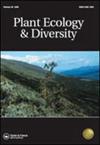A plot-based elevational assessment of species densities, life forms and leaf traits of seed plants in the south-eastern Himalayan biodiversity hotspot, North Myanmar
IF 1.7
4区 生物学
Q2 PLANT SCIENCES
引用次数: 0
Abstract
ABSTRACT Background : Species density along elevation gradients often shows hump-shaped patterns, but in-depth data for Myanmar is still not available. Aim : The first plot-based study to detect the elevational patterns of life forms and tree leaf traits, and their relation to environmental factors in Myanmar. Methods : All seed plant species were recorded on 76 plots between 400 and 4100 m. Regression models were used to identify the variables with highest predictive power for species densities of different life forms and leaf traits. Results : Species density showed a linear elevational decline except for grasses (increase) and epiphytes (hump-shaped pattern) and were related to temperature and precipitation in all considered life forms. Tree leaf size, the proportion of species with simple leaves and leaves with drip tips decreased with elevation, while the proportion of toothed leaves increased. Conclusions : Our data partly confirm some widely held assumptions about elevation patterns in species density and leaf traits. While the climatic dependence behaves as expected, leaf traits and lifeforms show mixed and sometimes surprising patterns. Previous knowledge of these patterns is partly confirming, but highly scattered regionally, so our study performed in one region offers a rare opportunity towards a natural history image of a biodiversity hotspot..缅甸北部喜马拉雅东南部生物多样性热点地区种子植物物种密度、生命形式和叶片特征的小区海拔评估
摘要背景:沿海拔梯度分布的物种密度通常呈驼峰状,但缅甸的深入数据仍不可用。目的:首次以小区为基础研究缅甸生命形式和树叶特征的海拔模式及其与环境因素的关系。方法:在400米至4100米的76个地块上记录所有种子植物物种。使用回归模型来确定对不同生命形式和叶片性状的物种密度具有最高预测能力的变量。结果:除草(增加)和附生植物(驼峰状)外,物种密度呈线性上升趋势,并且在所有考虑的生命形式中都与温度和降水有关。树的叶片大小、具有单叶的物种和具有滴水尖端的叶片的比例随着海拔的升高而降低,而齿叶的比例增加。结论:我们的数据部分证实了一些关于物种密度和叶片性状海拔模式的广泛假设。虽然气候依赖性表现如预期,但叶片特征和生命形式表现出混合的,有时甚至令人惊讶的模式。先前对这些模式的了解在一定程度上得到了证实,但在区域上高度分散,因此我们在一个区域进行的研究为绘制生物多样性热点的自然历史图像提供了难得的机会。。
本文章由计算机程序翻译,如有差异,请以英文原文为准。
求助全文
约1分钟内获得全文
求助全文
来源期刊

Plant Ecology & Diversity
PLANT SCIENCES-
CiteScore
3.30
自引率
0.00%
发文量
26
审稿时长
3 months
期刊介绍:
Plant Ecology and Diversity is an international journal for communicating results and novel ideas in plant science, in print and on-line, six times a year. All areas of plant biology relating to ecology, evolution and diversity are of interest, including those which explicitly deal with today''s highly topical themes, such as biodiversity, conservation and global change. We consider submissions that address fundamental questions which are pertinent to contemporary plant science. Articles concerning extreme environments world-wide are particularly welcome.
Plant Ecology and Diversity considers for publication original research articles, short communications, reviews, and scientific correspondence that explore thought-provoking ideas.
To aid redressing ‘publication bias’ the journal is unique in reporting, in the form of short communications, ‘negative results’ and ‘repeat experiments’ that test ecological theories experimentally, in theoretically flawless and methodologically sound papers. Research reviews and method papers, are also encouraged.
Plant Ecology & Diversity publishes high-quality and topical research that demonstrates solid scholarship. As such, the journal does not publish purely descriptive papers. Submissions are required to focus on research topics that are broad in their scope and thus provide new insights and contribute to theory. The original research should address clear hypotheses that test theory or questions and offer new insights on topics of interest to an international readership.
 求助内容:
求助内容: 应助结果提醒方式:
应助结果提醒方式:


